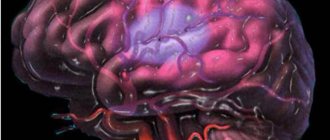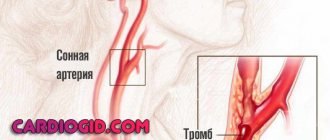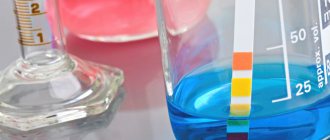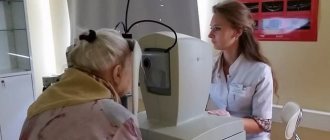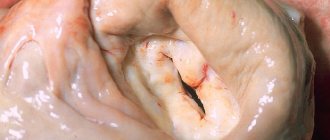Cerebral ischemia, to put it simply, is an insufficient supply of blood to the child’s brain. This can lead to disability and even cause death. In most cases, hypoxic-ischemic encephalopathy is diagnosed, and not strictly ischemia in recently born babies. Hypoxic-ischemic encephalopathy means that the cells do not receive the necessary doses of oxygen, which is why pathological processes begin in the brain.
- Causes
- Pathogenesis (essence of pathology)
- Risk factors for pathology
- Degrees
- Signs of severe ischemia
- Cerebral ischemia in prematurity and in full-term infants
- Hypoxia results
- Diagnostics
- Treatment
- Prevention of ischemia
Causes
In newborns, the pathology in question can be provoked by the following factors:
- During contractions and pushing, the umbilical cord is pinched, which affects the blood supply to the brain and other organs
- long labor
- placental abruption
- acute placental insufficiency
- asphyxia (suffocation) during childbirth
- intrauterine hypoxia
- prematurity, which causes respiratory failure in the baby
- patent ductus arteriosus
- disruption of blood flow to the heart
- congenital heart defects
- sepsis, which causes the child’s blood pressure to decrease
- heavy bleeding caused by various reasons
Pathogenesis (essence of pathology)
For the health and life of a child, oxygen is needed, which is carried through the blood to all organs and tissues of the body. If there is not enough of it, then the blood in the organs is redistributed; this is a natural regulation of the body. Blood with important oxygen begins to flow mainly to the heart and brain. At the same time, other organs experience a lack of both. If the cause of oxygen starvation is not eliminated, then asphyxia gradually develops, and the nerve cells will not be able to exist for so long. They die off. This is the essence of the process of cerebral ischemia in newborns.
It is logical that the greater the risk for a child, the larger areas of the brain that are damaged. In some children with such problems, blood spills into the brain, which can have very sad consequences.
Risk factors for pathology
On the mother's side, factors may be:
- epilepsy in a pregnant woman
- neurological pathologies in the family, in close relatives
- endocrine disorders, including thyroid dysfunction
- infertility therapy
- pathology of the placenta
- preeclampsia and eclampsia
- emergency caesarean section
- fever at the time of birth (body temperature more than 38˚ C)
- labor lasting up to 2 hours (called rapid labor in medicine)
- lack of professional medical assistance
- low birth weight
- gestation period up to 37 weeks
- The pregnancy period is more than 42 weeks.
- heavy bleeding during pregnancy and at the time of birth
But the presence of any of these reasons does not mean that the child will have hypoxia at the time of birth or after birth. They only affect how healthy the baby will be and how safe the birth will be. Many factors-causes are connected. For example, bleeding, abnormal placental function and condition, and low infant weight are associated. When they are combined, an emergency cesarean section is often prescribed or premature birth occurs. And in some cases, cerebral ischemia occurs in the newborn.
About 70 out of 100 babies with encephalopathy had developmental disorders and risk factors already when they arrived in the expectant mother’s belly. A quarter of the children also had less than healthy births. And only a small percentage of babies developed ischemia after they were born.
Complications and consequences
The development of cerebral ischemia in newborns causes oxygen deficiency-induced damage to its cells and causes very serious, often irreversible neurological consequences and complications that are correlated with the topography of the lesions.
Studies have shown that cerebral ischemia in newborns is more susceptible to pyramidal cells of the hippocampus, Purkinje cells in the cerebellum, reticular neurons of the perirolandic region of the cerebral cortex and the ventrolateral part of the thalamus, cells of the basal ganglia, nerve fibers of the corticospinal tract, midbrain nuclei, as well as neurons of the neocortex and brainstem brain
In full-term newborns, the cerebral cortex and deep nuclei are primarily affected; in premature newborns, diffuse destruction of the white matter cells of the hemispheres is noted, which causes chronic disability in surviving children.
And with global ischemia of brain stem cells (in which the centers for regulating respiration and heart function are concentrated), their total death and almost inevitable death occurs.
Negative consequences and complications of perinatal and neonatal cerebral ischemia of 2-3 degrees in young children are manifested by epilepsy, unilateral vision loss, delayed psychomotor development, motor and cognitive disorders, including cerebral palsy. In many cases, their severity can be fully assessed by the child’s age of three.
- Cerebral ischemia grade 1 in a newborn - causes, symptoms and treatment
[45], [46]
Degrees
- light
With mild ischemia, muscle tone increases, but not too much. Deep tendon reflexes in such children are enhanced. They suckle poorly, cry constantly, or, conversely, sleep constantly. During the first 3 days of life, manifestations of pathology are eliminated. Children who have not spent 9 months in their mother’s belly may have decreased rather than increased reflexes and muscle tone.
- average
- frequent apneas
- decreased grasping and sucking reflex
- sluggish Moro reflex
- decreased tendon reflexes
- weak muscle tone
Symptoms of moderate ischemia in newborns appear in the first 24 hours after birth. Doctors talk about a favorable prognosis if the symptoms of ischemia disappear within 14 days.
- heavy
- uncoordinated eye movements
- strabismus, nystagmus
- lack of reflexes that a newborn should normally have
- irregular breathing, such children have to be connected to a ventilator
- stupor or coma
- convulsions
- surges in blood pressure (BP)
- heart rhythm disturbances
What are the degrees of cerebral ischemia in a child?
Cerebral ischemia in newborns is presented in three degrees: mild, moderate and severe.
Cerebral ischemia of the 1st degree in a newborn is characterized by the fact that the baby is in an excited or depressed state from the first 4 to 7 days after birth.
They are treated in the maternity hospital, and then the child is observed by a neurologist.
With ischemic cerebral pathology of the 2nd degree, newborns experience convulsive states and pronounced neurological symptoms. If grade 2 cerebral ischemia is diagnosed, the child should be hospitalized.
The third degree is the most severe, characterized by serious neurological impairment, requiring urgent resuscitation measures. After the child is discharged, he will have a long rehabilitation period.
Mild cerebral ischemia in a newborn is characterized by:
- Slightly increased muscle tone.
- Deep tendon reflexes are sharpened.
- The child sucks poorly at the breast, is whiny and sleepy.
- Symptoms stop within the first three days.
If the child is premature, then ischemic manifestations of this degree are characterized by a decrease in reflexes and muscle tone.
With moderate cerebral ischemia in an infant, the following is observed:
- Decreased muscle tone and tendon reflexes
- The child throws his arms back with his head thrown back, sucking and grasping reflexes are weakened or not detected.
- Respiratory dysfunction in the form of pauses between inhalation and exhalation.
- Symptoms appear during the first day.
If the child recovers in the first couple of weeks, then the outcome is favorable.
Severe cerebral ischemia is characterized by the following:
- The child is in a stuporous or comatose state.
- Breathes irregularly and requires artificial ventilation.
- Muscle tone with tendon reflexes is reduced, Moro, sucking and grasping reflexes are not evident.
- There is a rhythmic inconsistency in the movements of the eyeballs with strabismus.
- Cardiac arrhythmia is evident.
- Convulsive states are manifested.
Signs of severe ischemia
- Disorders of internal organs, including the heart
- Coma, absence of tendon reflexes and muscle tone
- 0-3 points on the Apgar scale after the first 5 minutes of life
The Apgar scale evaluates the following signs from 0 to 2 points:
- color of the skin
- state of reflexes
- muscle tone
- breathing attempts
- heart rate
The condition of the newborn is determined one minute after birth and after five minutes. After 1 minute of life, the doctor decides whether the child needs resuscitation. At the fifth minute, you can determine if there is hypoxia that has affected the brain.
How is it diagnosed?
Manifestations of cerebral ischemia are observed during the first days after the baby is born. Mild encephalopathic conditions occur quickly, but in the severe stage, from several hours to 2-3 days, the baby’s well-being improves, then immediately deteriorates sharply.
The examination procedures include:
- Examining the child. The activity of reflexes with weight, height, and the results of the Apgar scale are assessed.
- Blood tests including general and electrolyte tests. They also check the coagulability and volume of oxygen and carbon dioxide in the blood.
- Carrying out magnetic resonance imaging.
- Ultrasound examination of the brain during the initial diagnosis.
- An electroencephalographic examination to assess seizure activity and brain changes.
Cerebral ischemia in prematurity and in full-term infants
At term and at prematurity, the nature of brain damage is different. If a baby is not carried to term for 9 months, he or she is at risk of periventricular leukomalacia (PVL). This means that the white matter of the brain, located near the ventricles, dies and cysts form there.
PVL causes dementia and cerebral palsy in those born before the 31st week of gestation.
And for those who spent the entire period in the mother’s belly, damage mainly occurs to the cerebral cortex, that is, to the gray matter. The consequences for the child will depend on where the necrotic zone is located and how large it is. In acute and severe asphyxia (suffocation), damage to the brain stem is likely. Therefore, the child will have problems with heartbeat and breathing, which in some cases causes death, that is, death.
Hypoxia results
A lack of oxygen to the brain can have the following results:
- Severe cerebral ischemia
This condition is fatal in a quarter to half of cases. The babies do not survive even a few days. Another scenario is pneumonia or another infection that kills the child a little later. Most of those who do not die are diagnosed with autism, cerebral palsy or dementia. And only 10% of survivors experience no consequences.
- Moderate ischemia
According to statistics, severe long-term consequences occur in 30 to 50% of children.
- Mild ischemia
The outcome in most cases is favorable, no disability is noted.
Diagnostics
Doctors usually find ischemia in a baby in the first few days after birth. If the degree of oxygen starvation is severe, then the child may be in a normal state for 3-4 hours or even several days, and then suddenly a very bad state occurs. Therefore, it is important to thoroughly examine the baby.
Examination of the baby . Doctors assess the patient's situation using the Apgar scale, which was discussed above. To do this, reflexes are checked, body weight and height are measured.
Analyzes:
- general blood analysis
- electrolytes
- coagulability
- gases
Magnetic resonance imaging is performed if cerebral ischemia is severe or moderate. MRI is almost never used for mild cerebral ischemia in a newborn. Using ultrasound, it is impossible to accurately determine encephalopathic processes, and it is worth considering that the result may be false positive. Ultrasound can be used to make a primary diagnosis, but other studies are required.
The current method is electroencephalography, abbreviated as EEG. Mandatory for children with severe degrees of the pathology in question. EEG makes it possible to detect hidden seizures. The method also shows how damaged the brain is and how active it can be. An EEG is also done to choose adequate treatment.
Cerebral ischemia in newborns
CEREBRAL ISCHEMIA is a diagnosis that doctors can make to newborn babies in the maternity hospital. It occurs due to insufficient oxygen supply to brain cells. The reason contributing to this deficiency can appear both during the mother’s pregnancy and during the birth of the child.
One of the first tests that doctors use immediately after the birth of a baby is the well-known Apgar score. The number of points determines the condition of the baby. The lower the score, the more severe the child’s condition, the greater the likelihood of this diagnosis. Doctors use the diagnosis of cerebral ischemia of newborns in the first month of a child’s life and divide the pathology into three degrees according to severity. The child's treatment depends on the severity.
The mildest is grade 1; as a rule, there are mild neurological symptoms, for example, in the form of increased excitability of the child, and the baby does not require hospital treatment. But in the case of the second, especially third degree, the issue of hospitalization of the baby in a specialized department of the hospital is decided. The first month is an acute condition. From the second month of life until the age of 1 year, there is a period of recovery of the nervous system affected by ischemia, and the neurologist, in diagnosing hypoxic-ischemic damage to the central nervous system, identifies the leading syndromes and selects treatment in accordance with this. One of the severe consequences of cerebral ischemia is cerebral palsy, which makes the child disabled from childhood.
During this second period of time, parental involvement in the restorative treatment process will be very important. Observation by a neurologist is necessary, and additional ultrasound examinations of the brain are required. Based on the results of the examination and research, the neurologist may refer you and your child to an appointment with an osteopath, and may also prescribe a course of medications. Most often, these drugs are from the group of vascular, nootropic drugs, as well as from the group of vitamins or diuretics. In some difficult cases, children need to be readmitted to the hospital to receive anticonvulsant therapy, intramuscular injections and drips.
What is required from parents?
Firstly, it is an attentive attitude towards your baby. Monitoring the child during the day, his sleep and wakefulness, his mental and motor development, his reaction to environmental influences. Do not neglect your doctor's orders. When making a scheduled visit to a neurologist, tell us about your observations of your child, this will help adjust the prescriptions.
An osteopath may also need such information. After an initial consultation with an osteopath, where time is allocated to collect all available data and direct osteopathic diagnosis, the tactics for managing the child are determined. More often than not, one procedure for correcting the found dysfunctions is not enough, and then the osteopath will prescribe a second appointment, which may be after 1-3 weeks.
What changes do parents observe in their child after treatment with an osteopath? Most often this is improved sleep, a decrease in unmotivated crying, regurgitation, positive changes in pre-speech and motor development. The neurologist observes positive dynamics during a neurological examination, and he has the opportunity to reduce the drug load on the child.
Treatment
To date, specific therapy that “revives” dead brain cells has not been developed. There are medical methods that stop the process of hypoxia and death so that the child does not die.
Treatment of acute ischemic period
As already noted, severe and moderate cerebral ischemia makes itself felt immediately, the symptoms are specific. If there is no spontaneous breathing in the first 2 minutes of life (as well as in the absence of breathing with an oxygen mask), resuscitation must be performed. do intubation and mechanical ventilation. If small areas of the brain are damaged, then 2-3 minutes after the start of resuscitation the baby is already breathing on his own. Then the child is given to the mother. Such a small patient is being observed.
If resuscitation takes longer, the baby is taken to the intensive care unit. There you need to constantly monitor the readings of the body’s condition, including the amount of glucose and hemoglobin in the blood, the level of gases, the processes of blood circulation and the beating of the newborn’s heart. There is special equipment for this.
Anticonvulsant therapy consists of prescribing special drugs, for example, phenytoin. The dose is selected by the doctor individually. This helps stop the seizures and prevents further brain damage. Since ischemia has a negative effect not only on the brain, but also on the heart, special therapy is needed for this organ. To prevent the little patient’s heart from stopping, he is injected with dobutamine and dopamine.
Today, research data is relevant that a temperature that is 3-4 degrees lower than normal can save parts of the brain from dying, which prevents disability and death. This method is called hypothermic therapy. It has been practiced not so long ago, only since 2010. It is necessary that the process be supervised by experienced doctors. The patient is warmed up gradually.
Treatment of consequences
As mentioned above, there are always consequences for a child with severe and even moderate cerebral ischemia. It could just be attention deficit disorder. But in other cases, mental retardation and cerebral palsy are noted. If there are convulsions, special drugs are used to stop them. Prescribed by a doctor in an individual dosage; self-medication is strictly prohibited.
If the baby has severe cerebral palsy with spasticity of the limbs, then muscle relaxants are taken to alleviate the situation. Whatever the consequences, treatment will not be limited to medications. Daily rehabilitation is important. Children with cerebral palsy are given special massage courses. This should be done by a specialist. At home, you can do only part of the exercises that experts will show parents. Older children who are diagnosed with cerebral palsy due to cerebral ischemia need exercise therapy.
Correction of incorrect postures is carried out using special devices: strollers, bolsters, splints, special chairs. If there is spasticity, the arms and legs of a sick baby may become unphysiological. It's better to avoid this.
In our country there are few specialists who can adequately treat the consequences of cerebral ischemia in newborns. There is overdiagnosis. Children under 6 months of age may have Graefe's sign, increased muscle tone and shuddering. And doctors may think that these are manifestations of encephalopathy. Accordingly, they will prescribe treatment that is actually unnecessary.
Newborns should not be examined when they are drowsy or frightened in some way. Then it is also possible to diagnose neurological pathologies that do not exist. Unnecessary medications that may be prescribed in error include:
- vascular
- nootropics
- homeopathy
Hypoxic-ischemic encephalopathy in children
A neurological examination of a newborn child should begin with the standardization of examination conditions, since inadequate room temperature and the nature of lighting affect the resulting reflexes, reactions, etc. The examination is carried out at the optimal room temperature of about 24-26 ° C after 1-2 minutes of adaptation of the child in the unfolded position. form under a radiant heat source. At low temperatures, it is more likely to get a reaction of increased muscle tone and tremor, at high temperatures - muscle hypotension. Lighting should be symmetrical in relation to the newborn, since light incident on one side causes a narrowing of the pupil and palpebral fissure on the side of illumination. During examination, it is necessary that the child’s head is in the sagittal plane, since due to the asymmetric cervical-tonic reflex, a decrease in muscle tone is noted on the side of the head rotation, and an increase on the opposite side.
It is also necessary to take into account the time that has passed since the last feeding, since after saturation the baby is relaxed, he may have reduced muscle tone and a number of reflexes and reactions, and before feeding the newborn may be in a state of relative hypoglycemia, leading to restlessness, tremors and increased muscle soreness. tone.
Next, it is advisable to determine the state in which the newborn is, since the same indicators of reflexes and reactions can be physiological for one state of the child and pathological for another.
The sociability of a newborn as the main indicator of general activity is assessed by the reaction of displeasure in the presence of discomfort (forced awakening, hunger, wet diapers, etc.) and the speed of calming when eliminating irritating factors, as well as by the response to positive stimuli (response to affectionate speech, stroking, picking up).
The interaction between the child and the doctor is essential in determining the communication skills and behavior of a newborn, and therefore the role of not only the newborn’s reactions is important, but also the doctor’s persistence in receiving them, his positivity towards the child during examination. To assess a child’s sociability, the difference in auditory and visual reactions to animate (the doctor’s face and voice) and inanimate (artificial and natural light sources, rattle, bell, clap) stimuli is important. The presence of search, palm-oral, grasping reflexes and the Babinsky reflex indicates the presence of tactile sensitivity. Pricking a child with a needle causes frowning of the eyebrows, clenching of the eyes, wrinkling of the nasolabial furrow, opening of the mouth, pouting of the lips, stretching of the mouth, tension of the tongue, trembling of the chin, screaming, as well as a motor reaction: flexion with adduction of the limbs. A painful reaction occurs a few seconds after the application of irritation, which is due to slow conduction through the nerves of the newborn due to insufficient myelination.
A decrease in the listed reactions may be either a sign of depression of the central nervous system as a result of a number of somatic and neurological diseases, or damage to the corresponding analyzer. Thus, lack of response to pain may be a consequence of hereditary sensory polyneuropathy.
Among the signs of the child’s general activity, spontaneous motor activity should be noted. Its assessment is quite subjective and depends on the doctor’s experience, but objectification is possible only by analyzing a video recording of activity for 1 hour. Typically, spontaneous movements consist of periodic flexion and extension of the legs, their crossing, pushing away from the support; movements of the hands at chest level in the elbow and wrist joints with clenching of fists. The presence of a choreoathetoid component in movements, which is physiological for newborns, indicates the predominance of extrapyramidal (striatal) motility and consists in restlessness of the tongue, spreading and independent movements of the fingers.
The facial expressions of a newborn are quite rich and, as a rule, symmetrical and consist of squeezing the eyes, frowning the forehead, deepening the nasolabial folds, tense the tongue, and open the mouth. Facial asymmetry is possible on the first day due to the peculiarities of the passage of the baby’s head through the birth canal. On the other hand, facial asymmetry may be due to damage to the cranial innervation.
The doctor studies the child’s pupils, the movement of the eyeball, the state of the palpebral fissure, etc., the symmetry of mouth opening when yawning and screaming, swallowing, screaming, and the muscles of the tongue.
It should be noted that tremor as a periodic oscillation around a fixed axis of a certain amplitude and frequency occurs in almost half of newborns. Low-amplitude, high-frequency tremor when a newborn is crying or excited, as well as in some stages of sleep, is a physiological phenomenon. In terms of prevalence, tremor can affect the chin, tongue, and limbs.
Muscle tone is the most important characteristic of the motor activity of a newborn. We can talk about the child’s active muscle tone (posture) and passive, the value of which is determined by checking mobility in the joints. A healthy full-term baby has a so-called fetal position due to a flexor increase in tone (arms are bent in all joints, brought to the body and pressed to the chest, hands are clenched into fists, the thumbs of the hands lie under the other four; legs are bent at the joints and abducted in hips, dorsiflexion predominates in the feet). In some cases, a predominant physiological increase in muscle tone in the arms compared to the legs and neck extension are noted. The active muscle tone of the newborn can also be judged by holding the baby in the air face down, with the baby's head in line with the body, the baby's arms slightly bent and legs extended. “Sinking” of the child’s head when he is pulled up by the shoulder girdle (symptom of “flaccid shoulders”) in full-term newborns occurs both with hypoxic parasagittal lesions of the brain and with injury to the cervical spinal cord.
The assessment of reflex activity is carried out on the basis of at least three tests of this reflex. If the reflex amplitude is maintained in all three tests or the amplitude decreases slightly in the third, the reflex is considered normal; if the initial amplitude value is low, persists in three tests or progressively decreases with repeated testing of the reflex, and also if repeated stimulation is necessary to obtain the reflex, it is considered reduced.
Testing of abdominal and cremasteric reflexes is of limited value in neonatology due to their variability in detection and severity.
Of particular importance is checking the reflexes of newborns (“primary”, “unconditioned” reflexes). Most of the reflexes of newborns reflect the evolutionary maturity of the child, his functional state, and only some of them have a specific topical significance. Due to their large number, it is necessary to focus on the most informative ones. When stroking the baby's skin in the area of the corner of the mouth, the head turns towards the stimulus (search reflex), when a finger lightly touches the newborn's lips, the lips stretch (proboscis reflex), and when a pacifier is placed in the mouth, sucking movements occur (sucking reflex). When pressing on the thenar area, the child opens his mouth, tilts his head, bends his shoulders and forearms (Babkin's palmar-oral reflex), when placing fingers in the newborn's hand, the researcher's fingers are grasped (upper grasp reflex), and if the child can be lifted, the Robinson reflex occurs. When the skin of the back along the spine is irritated, the newborn bends the torso in an arc open towards the irritation (Galant reflex). A child raised under the armpits bends his legs in all joints, and when placed on a support, he stands on half-bent legs (support reflex); when bending forward, the child makes stepping movements (stepping reflex), while crossing his legs in the lower third of the lower leg is possible. In the position of the child on his stomach, when the researcher’s palms are applied to his feet, a reflex repulsion and crawling occurs (Bauer reflex). When pressing on the ball of the foot in the area of the II-III toe, plantar flexion occurs (inferior grasping reflex of Verkom), and when the sole is irritated by strokes, its extension and fan-shaped divergence of the toes occurs (Babinsky reflex).
It should be noted that a dynamic study of the state of the nervous system of healthy newborns indicates the presence of transient physiological changes in the neurological status of the child in almost half of the children. Therefore, to classify a particular deviation in the neurological status of a newborn as physiological or pathological, it is necessary to evaluate it in connection with other phenomena, dynamic observation, and in some cases the use of adequate additional research methods.
The neurological status of the newborn can be normal or deviant, and among the options for the latter, one of the following neurological syndromes is noted: increased excitability, muscle hypertension or hypotension, apathy, hemisyndrome; or their combinations. In Russia, the most common classification of lesions of the nervous system in newborns and young children is Yu. A. Yakunin et al. Within the framework of this classification, hypoxic encephalopathy is considered as a particular manifestation of the pathology of the nervous system of this period. In the classification of Yu. A. Yakunin et al. consider the periods of action of the harmful factor: prenatal (embryonic, early fetal) and perinatal (antenatal or late fetal, intranatal and neonatal). The dominant factors, in addition to hypoxia, include trauma, infection, intoxication, inborn errors of metabolism, chromosomal aberrations, unspecified and unclassified conditions. According to the severity, encephalopathy can be mild, moderate, or severe. Among the levels of damage are the meninges, cerebral cortex, subcortical structures, trunk, spinal cord, peripheral nerves, combined forms.
Prevention of ischemia
It is necessary to talk about pregnancy in advance. Preparations begin half a year, or at most 3 months before conception. And not only the expectant mother, but also the father of the child must prepare. During gestation, a woman should undergo all examinations on time, especially in the first trimester. Tests are taken and ultrasound diagnostics are performed.
Before and during pregnancy, a woman is examined for infections. As is known, after conception, latent infections can worsen and manifest themselves. Mom needs to give up smoking, alcohol, drugs and other habits that are harmful to her and the baby. Smoking has a particularly negative effect on the process of oxygen supply to the fetus. If the doctor discovers pregnancy complications, it is important for the woman to go to the hospital on time.
